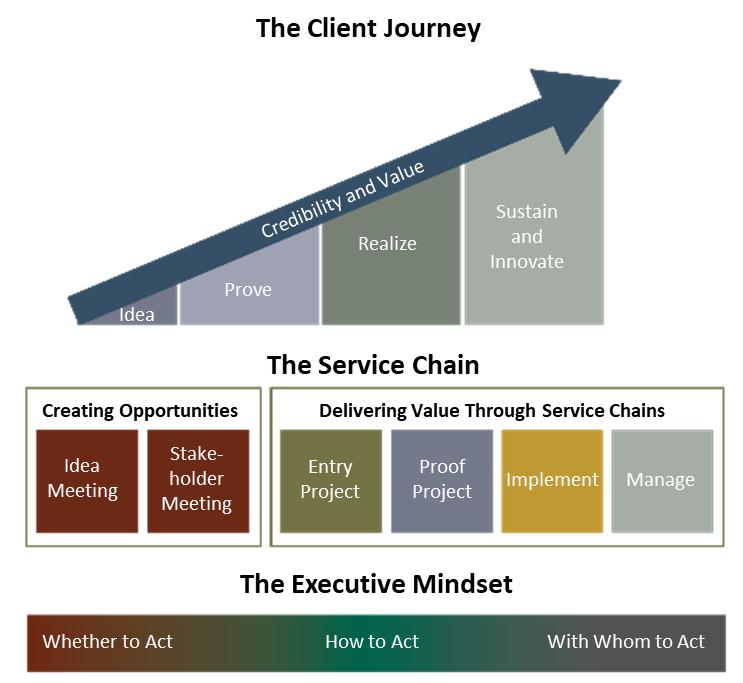This is the first blog in a series on the topic of Service Chains.
Service ChainsSM are a key building block to becoming less opportunistic and more deliberate in your go-to-market approach.
Let’s examine what we mean by the term Service ChainSM.
Service ChainsSM comprise a pre-defined set of sales activities and projects that collectively deliver your solution and value proposition in a manner that facilitates the buyer’s journey to understand, evaluate, and implement new ideas.
The fundamental premise of the Service ChainSM is disaggregation of the big purchase decision (i.e., buying the total solution) into smaller decisions scoped and sized to match the buyer’s position in their purchasing journey – the buyer’s investment grows as the understanding, credibility, and value achieved or achievable increases.
Service ChainsSM are the primary method to formalize the topics and ideas from the Portfolio into executable “how to play” offerings designed for differentiation, intimacy, and/or pull through. Specifically, Service ChainsSM:
- Formalize the deliverables of the client engagements and use those deliverables to build credibility and intimacy
- Create a predictable stream of work that pulls through major revenue sources
- Reduce the overall sales investment and the risk – for both you and the buyer
- Provide the basis for account plans, communication plans, and executive interactions
- Support demand creation by aligning to the way that an executive makes a buying decision
- Allow selling higher into the organization to executives who set budgets and direction, rather than those who manage budgets – i.e., executives who are above the “Line of SafetySM”
By way of analogy, most successful marriages are not proposed after simply viewing an on-line profile or from a mutual friend’s gushing description of a potential mate. The couple starts with coffee, drinks, or dinner where they learn a little bit about each other. If either party is unsatisfied with the interaction, either can bow out of future interactions without having made a significant investment or commitment. If both parties remain interested, they continue dating and exploring their potential synergy followed by an engagement period. Bowing out at these later stages means more time and investment was “lost,” but both parties made informed decisions along the way. Finally comes the marriage based on this mutual exploration and interaction that built trust and understanding of each other’s unique strengths, and weaknesses, foibles and virtues – and synergies as a couple. Both enter the marriage fully informed, fully committed, and in a relationship built around their unique personalities. Service Chains deliberately provide a first date, a “going steady” phase, an engagement period, and only after that, a marriage – a process intentionally designed to glean mutual understanding, develop credibility, and tailor the relationship – starting from obtaining the first meeting through conducting sales meetings and guiding the client through a series of tollgates or decisions that consummate in the product(s) or service(s) that constitutes the traditional view of an offer (the marriage).
The graphic below shows the fundamental structure of a Service Chain and its relationship to executive buying decisions.

In our next post, we will explore the different components of a Service ChainSM.
To read the next blog in this series, click here.
Written by: Doug Long
About the Author: Doug Long is a Partner with McMann & Ransford and has more than 26 years of experience in consulting across various industries, topics, and client challenges. Prior firms include Deloitte and GE. He currently leads our Healthcare Practice.
